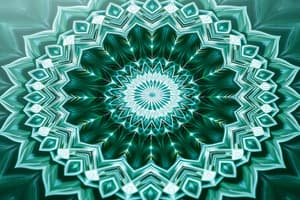Podcast
Questions and Answers
Which natural patterns can be observed in animal markings?
Which natural patterns can be observed in animal markings?
- Zebra Stripes and Butterfly (correct)
- Old Pottery Surface and Drying Inelastic Mud
- Honeycomb and Fish Scales
- Branching of Trees and Fern Leaves
What is an example of a pattern found in plants?
What is an example of a pattern found in plants?
- Seed head of sunflower (correct)
- Snowflakes
- Star Fish
- Water splash
Which of the following is a type of symmetry observed in nature?
Which of the following is a type of symmetry observed in nature?
- Butterfly (correct)
- Old Pottery Surface
- Fish Scales
- Drying Inelastic Mud
Which of these patterns can be commonly seen in both art and nature?
Which of these patterns can be commonly seen in both art and nature?
Which of the following patterns is associated with insect structures?
Which of the following patterns is associated with insect structures?
Flashcards
Symmetry in Nature
Symmetry in Nature
A symmetrical object can be divided into two identical halves along a line of symmetry.
Repeating Patterns
Repeating Patterns
A pattern that repeats in a predictable way.
Spiral Patterns
Spiral Patterns
Patterns in nature often exhibit a spiral shape.
Patterns in Nature
Patterns in Nature
Signup and view all the flashcards
Patterns in Art, Music, and Language
Patterns in Art, Music, and Language
Signup and view all the flashcards
Study Notes
Chapter 1: Nature of Mathematics
- Learning Outcomes:
- Recognize the significance of mathematics in everyday life
- Explain the value of mathematics in daily life
- Identify patterns and regularities in the natural world
- Understand and illustrate the Fibonacci sequence
Chapter 1.1: Patterns and Numbers in Nature and the World
- Patterns: Recurring and predictable arrangements of objects, events, or actions, perceived as meaningful or significant
In Mathematics: Fibonacci Sequence
- The Fibonacci sequence is (0, 1, 1, 2, 3, 5, 8, 13, 21, 34)
- This sequence is prevalent in nature (e.g., sunflowers, pinecones, Romanesco broccoli, seashells, galaxies)
In Art
- Repeated design
- Shapes
- Colors
- Tessellations
In Music
- Rhythm
- Melody
- Harmony of a piece
- Repeated chorus of a song
In Language
- Structure and grammar of a sentence
- Subject-Verb-Object (SVO) pattern
- Subject: Who or what the sentence is about
- Verb: What the subject is doing or the action
- Object: Who or what receives the action
In Nature
- Shapes and structures of plants and animals
Real-Life Applications of Patterns
- Symmetry
- Balanced and harmonious arrangement of identical or similar parts
- Types of Symmetry:
- Bilateral Symmetry: Mirror image of each other
- Radial/Rotational Symmetry: Has a central point.
- Fractals: Never ending pattern (e.g., fern leaves, branching of trees)
- Spiral: Circling around a central point (e.g., sheep horn, seed head of a sunflower, Aloe polyphylla)
- Waves and Dunes: Alterations in space or matter transmitting energy (e.g., ocean waves, sand dunes)
- Tessellations: Tile patterns created by repetition (e.g., honeycomb, fish scales, scales of snake fruit)
- Cracks or Fractures: Linear slits releasing tension in materials (e.g., old pottery surface, dry mud)
- Stripes and Spots: Succession of bands (e.g., butterflies, zebras)
- World Population: Understanding trends and phenomena
Why Learn Mathematics?
- Mathematics is essential in daily life and advanced scientific research.
- Mathematics helps solve problems, organize activities (like playing games, art, spending money etc), and allows for technological innovation.
Examples
- Telling time involves numbers and other math skills
- Measuring distances uses rulers or tape measures
- Using money involves counting, saving, and spending money math skills.
- Weighing involves using scales.
- Adding or dividing is possible with calculators
- Construction uses math to determine sizes and measures needed
- Cooking uses math to measure ingredients.
Studying That Suits You
Use AI to generate personalized quizzes and flashcards to suit your learning preferences.



